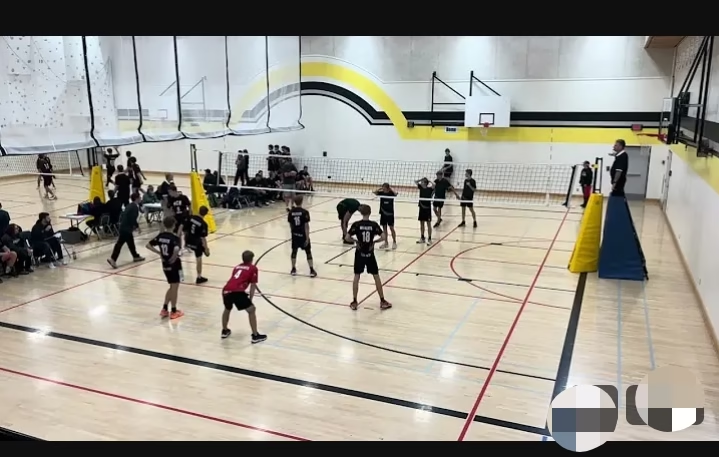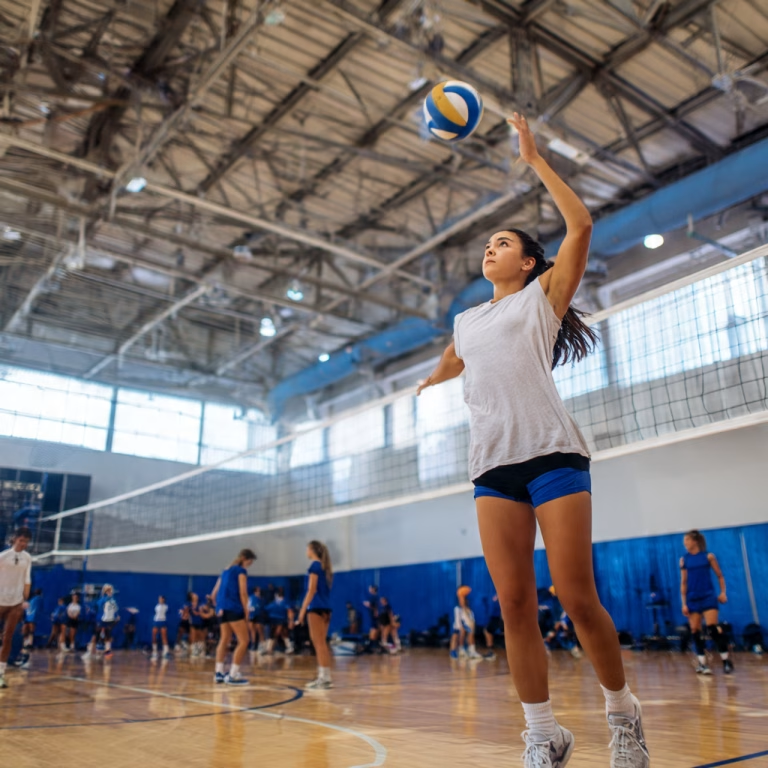Zones in volleyball play a crucial role not only in understanding the court layout but also in tactical setups, player placement or positioning, serving, and attacking strategies. Below, we’ll take a closer look at the zones in volleyball, the dimensions, and their functions in the game. Let’s begin with the general dimensions of a volleyball court.
General Dimensions of a Volleyball Court
A standard volleyball court, according to (FIVB) international rules, is rectangular with the following dimensions:
- Length: 18 meters
- Width: 9 meters
Around the main court lies the free zone, which ensures safe playing conditions. Its dimensions are typically:
- 3–5 meters on the sides
- 3–8 meters behind the end lines
The free space above the court (ceiling height or open-air space) should be at least 7–8 meters.
See Also: What Are the Major Tournaments for Volleyball?
What Are the Zones in Volleyball?
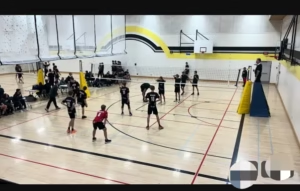
The zones in volleyball refer to specific areas or spots on the court, each serving a unique purpose. These zones help players position themselves for offense, defense, and serving. A standard volleyball court is divided into six zones, which are essential for smooth gameplay.
The 6 Zones in volleyball
- Front Zone or Attack Zone
- Back Zone
- Serving Zone
- Free Zone
- Substitution Zone
- Libero Zone
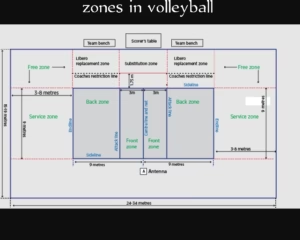
1. Front Zone (Attack Zone)
The front zone, also known as the attack zone, is the area closest to the net. It extends 3 meters from the net on both sides of the court. This is where attackers and blockers position themselves to execute powerful spikes and block opposing attacks. Here is the breakdown of key details of the front zone in volleyball:
- Location: Between the net and the “three-meter line,” which is 3 meters from the center of the court under the net.
- Depth: 3 meters from the net.
Functions:
- The front zone is where players specializing in blocking and attacking (middle blockers, outside hitters) position themselves.
- Players in the front row are allowed to attack the ball above the net’s height without restrictions.
- Back-row players can attack “above the net” only if they jump from behind the three-meter line.
2. Back Zone
The back zone lies behind the attack zone and stretches to the end line. Players in this zone focus on receiving serves, digging attacks, and setting up plays for their teammates. Below are the key details of the back zone in volleyball:
- Location: Between the three-meter line and the end (baseline) line of the court (9 meters).
- Depth: 6 meters (from 3 m to 9 m).
Functions:
- This is where players responsible for receiving and defending (libero, back-row hitters) are positioned.
- Players here focus on serve reception and defensive actions.
- Back-row players can only attack if they jump from behind the three-meter line.
3. Serving Zone
The serving zone is located behind the end line. Players must serve from within this area, ensuring they don’t step on or over the line during the serve. Key takeaway:
- Location: Behind the baseline, usually across the entire width of the court (9 meters).
Functions:
- This is where the serve is initiated.
- Players can choose a specific spot in the serving zone to make their serve more challenging for the opponent.
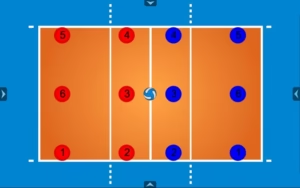
4. Free Zone
The free zone surrounds the court and extends 3–5 meters on all sides. Players can move into this zone to chase the ball during a rally. This area allows for greater flexibility and dynamic play.
- Location: Surrounds the main court on all four sides.
- Width: 3–5 meters (on the sides) and 3–8 meters (behind the end lines).
Functions:
- Allows players to move freely outside the main court to chase the ball during rallies.
- Ensures safety and comfort during dynamic gameplay.
Read more: Underhand Serve in Volleyball: Meaning and Step-by-Step Guide
5. Substitution Zone in volleyball
The substitution zone is near the sideline, between the attack line and the scorer’s table. It’s where players enter and exit the court during substitutions.
- Location: Along the sideline, near the scorer’s table.
Functions:
- Players pass through this area during official substitutions.
- This is also where the substitute players and benches are typically located.
Read more: Substitution zone in Volleyball: Here is what you should know
6. Libero Zone
While not officially marked, the libero zone refers to the area where the libero primarily operates. This defensive specialist focuses on receiving serves and digging attacks, usually in the back zone.
Read more: Volleyball Players Positions and Roles Explained
Net Height
Although the net height doesn’t form a separate zone, it significantly impacts the game:
- Men: 2.43 meters
- Women: 2.24 meters
- Youth and junior categories: The height varies depending on the age group.
Importance of Zones in Volleyball
- Player Distribution: It’s crucial to know who is “in front” (for attacking) and who is “in the back” (for defense).
- Back-row Attacks: These are only allowed if the player jumps from outside the front zone.
- Defensive Organization: Back-row players have a clear view of the entire court and coordinate defensive actions.
- Serving: Choosing a spot in the serving zone can make it harder for the opponent to receive.
- Free Zone: This area allows players to save “emergency” balls that go out of bounds.
Recommendations for Court Setup
- Appropriate Flooring: Non-slip, safe for diving and jumping.
- Court Markings: Lines should be 5 cm wide (usually white) and clearly visible against the floor.
- Safety: Net posts should be placed outside the free zone to avoid interfering with gameplay.
- Adequate Ceiling Height: At least 7–8 meters, with no obstacles that could disrupt the ball’s trajectory.
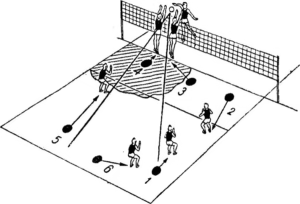
How Zones in Volleyball Shape Strategy
The zones in volleyball are not just about positioning—they influence the strategy and flow of the game. For example:
- Attackers in the front zone aim to score points with spikes and blocks.
- Defenders in the back zone focus on preventing the ball from touching the ground.
- The serving zone sets the tone for the rally, with players aiming for precise and challenging serves.
Understanding these zones helps teams coordinate their movements and execute plays effectively.
Read more: The 6 types of Moves in Volleyball
Diagram of Volleyball Zones
Visualizing the court layout is essential for grasping the concept of zones. Picture a standard volleyball court:
- The court measures 18 meters long and 9 meters wide.
- The front zone extends 3 meters from the net, while the back zone occupies the remaining 6 meters.
- The free zone adds 3–5 meters around the court for movement.
This layout ensures every player has a designated role and space to operate.
Common Mistakes in Understanding Zones
- Misinterpreting Boundaries: Players often confuse the attack line with the end of the front zone. Remember, the front zone is only 3 meters from the net.
- Stepping Out of Zones: During serves or plays, stepping out of the designated zone can result in penalties.
- Improper Positioning: Players in the wrong zone during rotation can disrupt team strategy and lead to errors.
FAQs About Zones in Volleyball
1. What is the difference between the front and back zones in volleyball?
The front zone is closer to the net and is primarily used for attacking and blocking. In contrast, the back zone is for defensive plays like receiving serves and digging attacks. Each zone has specific roles and responsibilities for players.
2. Can players step into the free zone during play?
Yes, players can step into the free zone to chase the ball during rallies. The free zone provides extra space for dynamic movements and ensures the game flows smoothly.
3. What happens if a server steps out of the serving zone?
If a server steps out of the serving zone or touches the end line while serving, it results in a fault, and the opposing team earns a point.
4. How do zones affect player rotations?
In volleyball, players rotate clockwise after winning a rally. Each player must occupy the correct zone during rotations to avoid penalties. For example, a back-row player cannot attack from the front zone unless they jump from behind the attack line.
5. Why is the libero restricted to certain zones?
The libero is a defensive specialist and cannot perform front-row attacks. They are limited to the back zone, where they focus on digging and passing to maintain the team’s defense.
Read more: Top 10 Highest Paid Volleyball Players in the World (2024 update)
Conclusion
Understanding and effectively using each zone is a critical element of volleyball tactics and technique. It helps with proper player positioning, choosing the type of attack or serve, and organizing defense.

